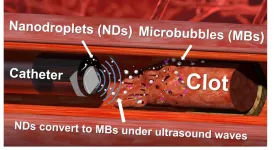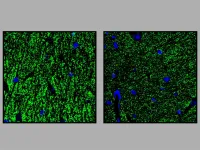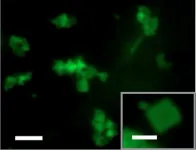(Press-News.org) The COVID-19 pandemic has seen hardware developers clamouring to make 'open source' technology to support our frontline services. Their intentions have been honourable - an invitation to teams across the world to collaborate in developing essential equipment such as ventilators, thereby making the process of producing critical instruments more effective, both in time and cost.
In practice, however, most developers of hardware have shown little 'openness' in their sharing of designs, a fact lamented by a group of physicists from the University of Bath in the UK, in a paper published this week in The Design Journal.
According to the group, the pandemic has highlighted serious flaws in a system that forces research groups around the world to start from scratch every time a tweak needs to be made to an existing instrument, simply because they can't get their hands on the original designs.
"The term 'open source' is being applied to the final design of an instrument - and I'm pleased to say there has been a willingness during the pandemic to share these final designs - but the design process itself also needs to be open, something it isn't now," explains physics researcher Dr Julian Stirling.
Dr Stirling uses a fictional scenario to describe the problem with the current model of open design: "Alice, a university researcher, gets public funding to create a new type of microscope, the NewScope. She spends two years developing this instrument and eventually gets it working.
A paper is published describing the principles behind her microscope, but the designs themselves are sold to a company. From these designs, the company produces the Fab NewScope. The instrument is popular with scientists and they are happy to buy it.
"Then Bob, another researcher, has an idea that will improve the Fab NewScope, and he gets public funding to make these improvements. But he doesn't have access to the designs for the NewScope, so he has to start from scratch. Bob spends two years creating his improved NewScope, 18 months of which are spent redesigning the original microscope. He makes most of the same mistakes as Alice and goes down many of the same dead ends.
"Eventually, the NewScope+ is complete and a paper describing the principles behind it is published, but the designs themselves are sold to a company. Some time later, Charlie has a great idea for improving NewScope+ and so the whole process of reinventing the NewScope starts again."
Dr Stirling believes complete openness is needed at every point in the design process, not least because hardware designs are generally generated by academics from public funds.
"If the public is funding a generation of knowledge, they should have access to it," he says. "For a company to collect the data that comes from this public-funded knowledge and then patent it seems a bit perverse to me."
During the pandemic, many large tech companies - including Amazon, Microsoft and IBM - have signed the Open COVID pledge in recognition of the need for them to apply every tool at their disposal to halt the pandemic and treat those affected. The pledge is to make intellectual property available free of charge where it can be put to use in the fight against Covid-19. Dr Stirling welcomes this gesture of goodwill but he points out that the pledge is time-limited.
"So when the next pandemic hits, we'll be back in the same situation."
This year has seen a surge in the development of ventilators to treat those most severely affected by the Covid virus, and participants of the open-source pledge have showed willing in sharing their ventilator designs. However, as Dr Stirling explains, for legitimate legal and liability reasons, many pledge signatories have adopted an open-when-finished model, meaning their final design plans are open for others to use but their engineering efforts happen behind closed doors, so remote teams aren't able to collaborate in real time.
"There has been a proliferation of projects with teams across the world independently designing over a hundred mutually incompatible ventilators," said Dr Stirling. "This a huge amount of duplicated effort."
Dr Stirling believes the way forward is for universities to give more support to staff who wish to engage in open design. He also calls on governments to clarify the liability of individual teams contributing to open design, so researchers are more willing to share their ideas throughout the design process without fearing they could face a lawsuit if a manufacturer produces a malfunctioning product from their prototype design. He also highlights that the regulatory process may be a barrier for open-source designs, as a manufacturer is required to understand and explain why a device has been designed the way it has.
"Ultimately, it is a device not a design that gets certified. It has to be this way as you don't want anyone manufacturing a ventilator - you want accredited trained professionals," said Dr Stirling. "If a manufacturer only sees your final design, how can they understand it enough to take legal responsibility? With an open design process, transferring this knowledge should be possible."
For the past five years the same research group has worked on the design for an open-source microscope that is now being adapted by individuals and organisations around the world. The 3D printed OpenFlexure Microscope is highly customisable, meaning it be can adapted for laboratory, school and home use. The project has evolved such that every step of the design process is openly available.
"The more we work in the open, the less time we waste re-explaining the same issues to collaborators. This body of knowledge about the design is so important for our Tanzanian collaborators as they work to develop the design into a certified medical diagnostic device."
INFORMATION:
Whenever an organism develops and forms organs, a tumour creates metastases or the immune system becomes active in inflammation, cells migrate within the body. As they do, they interact with surrounding tissues which influence their function. The migrating cells react to biochemical signals, as well as to biophysical properties of their environment, for example whether a tissue is soft or stiff. Gaining detailed knowledge about such processes provides scientists with a basis for understanding medical conditions and developing treatment approaches.
A team of biologists and mathematicians at the Universities of Münster and Erlangen-Nürnberg has now developed a new method for analysing cell migration ...
Engineering researchers have developed a new technique for eliminating particularly tough blood clots, using engineered nanodroplets and an ultrasound "drill" to break up the clots from the inside out. The technique has not yet gone through clinical testing. In vitro testing has shown promising results.
Specifically, the new approach is designed to treat retracted blood clots, which form over extended periods of time and are especially dense. These clots are particularly difficult to treat because they are less porous than other clots, making it hard for drugs ...
PHILADELPHIA - Medical school curriculums may misuse race and play a role in perpetuating physician bias, a team led by Penn Medicine researchers found in an analysis of curriculum from the preclinical phase of medical education. In a perspective piece published Tuesday in the New England Journal of Medicine, the researchers identified five key categories in which curriculum misrepresented race in class discussions, presentations, and assessments. The authors recommend that rather than oversimplifying conversations about how race affects diseases' prevalence, diagnosis, and treatment, medical school faculty must widen the lens to "impart an adequate and accurate understanding of the complexity ...
FOR IMMEDIATE RELEASE
In what is believed to be the most comprehensive molecular characterization to date of the most common type of head and neck cancer, researchers from the Johns Hopkins departments of END ...
As the planet continues to warm, the twin challenges of diminishing water supply and growing energy demand will intensify. But water and energy are inextricably linked. For instance, nearly a fifth of California's energy goes toward water-related activities, while more than a tenth of the state's electricity comes from hydropower. As society tries to adapt to one challenge, it needs to ensure it doesn't worsen the other.
To this end, researchers from UC Santa Barbara, Lawrence Berkeley National Laboratory and UC Berkeley have developed a framework to evaluate how different climate adaptations may impact this water-energy nexus. Their research appears in the open access journal Environmental Research Letters.
"Electricity and water systems are linked in many ...
Impaired intelligence, movement disorders and developmental delays are typical for a group of rare diseases that belong to GPI anchor deficiencies. Researchers from the University of Bonn and the Max Planck Institute for Molecular Genetics used genetic engineering methods to create a mouse that mimics these patients very well. Studies in this animal model suggest that in GPI anchor deficiencies, a gene mutation impairs the transmission of stimuli at the synapses in the brain. This may explain the impairments associated with the disease. The results are now published ...
INDIANAPOLIS-- Researchers at the Indiana University Melvin and Bren Simon Comprehensive Cancer Center published promising findings today in the New England Journal of Medicine on preventing a common complication to lifesaving blood stem cell transplantation in leukemia.
Sherif Farag, MD, PhD, found that using a drug approved for Type 2 diabetes reduces the risk of acute graft-versus-host disease (GVHD), one of the most serious complications of blood stem cell transplantation. GVHD occurs in more than 30 percent of patients and can lead to severe side effects and potentially fatal results. Farag is ...
Chemists have developed a nanomaterial that they can trigger to shape shift -- from flat sheets to tubes and back to sheets again -- in a controllable fashion. The Journal of the American Chemical Society published a description of the nanomaterial, which was developed at Emory University and holds potential for a range of biomedical applications, from controlled-release drug delivery to tissue engineering.
The nanomaterial, which in sheet form is 10,000 times thinner than the width of a human hair, is made of synthetic collagen. Naturally occurring collagen is the most abundant protein in humans, making the new material intrinsically biocompatible.
"No one has previously made collagen ...
Alexandria, Va., USA -- The COVID-19 pandemic has significantly impacted dental education and training. The study "COVID-19 and Dental and Dental Hygiene Students' Career Plans," published in the JDR Clinical & Translational Research (JDR CTR), examined the short-term impact of the COVID-19 pandemic on dental hygiene and dental students' career intentions.
An anonymous online survey was emailed to dental and dental hygiene students enrolled at Virginia Commonwealth University School of Dentistry, Richmond, USA. The survey consisted of 81 questions that covered a wide range of topics including demographics, anticipated educational debt, career plans post-graduation, ...
CHAMPAIGN, Ill. -- In almost all successful advertising campaigns, an appeal to emotion sparks a call-to-action that motivates viewers to become consumers. But according to research from a University of Illinois Urbana-Champaign expert who studies consumer information-processing and memory, emotionally arousing advertisements may not always help improve consumers' immediate memory.
A new paper co-written by Hayden Noel, a clinical associate professor of business administration at the Gies College of Business at Illinois, finds that an ad's emotional arousal can have a negative effect on immediate ...




